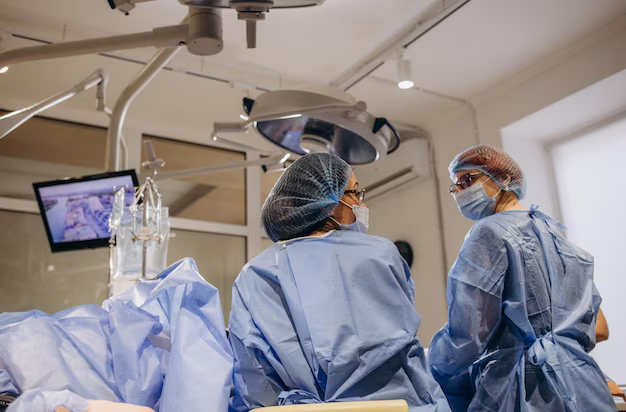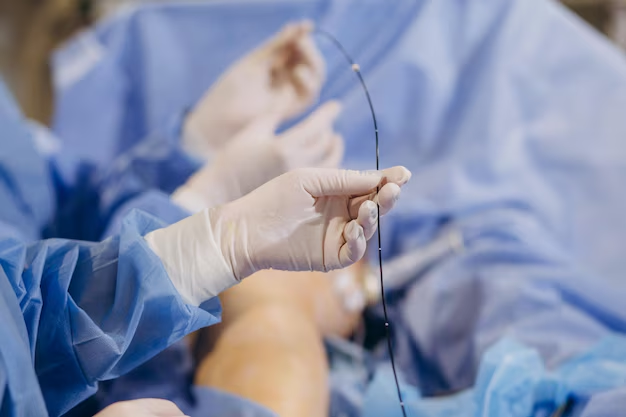What is vascular surgery?
Vascular surgery refers to open surgeries and minimally-invasive procedures that treat a range of blood vessel problems. These include aortic aneurysms, peripheral artery disease, carotid artery disease and chronic venous insufficiency. Common procedures include angioplasty and stenting, arterial or venous bypass surgery and aortic aneurysm repair.
Vascular surgery is an umbrella term for a range of open surgeries and minimally-invasive procedures involving your blood vessels. Your blood vessels are a network of arteries, veins and capillaries that carry blood to and from your heart and nourish your organs and tissues. Many different vascular diseases can damage your blood vessels and raise your risk of complications.
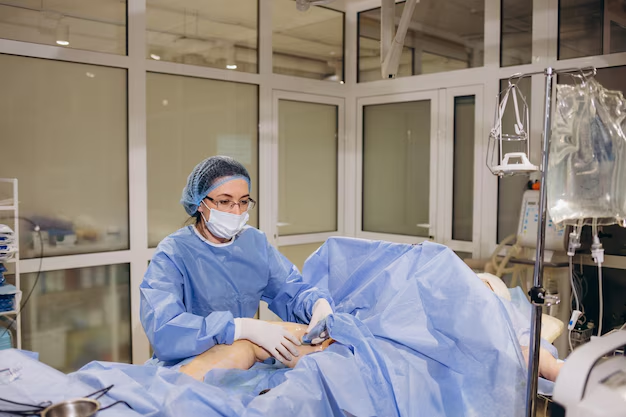
The Vascular Surgery Department at Academic Hospital looks after patients with diseases of the arteries, veins, and lymphatic vessels not associated with the brain or the heart. Our department is leader in the delivery of vascular surgery care in Turkey. We provide easy access to evaluation and treatment for the full range of blood vessel disorders from complex abdominal aortic aneurysms to varicose veins, utilizing the latest noninvasive diagnostic and surgical technology.
Our vascular surgeons are among the Turkey’s most successful providers of diagnosis and management of vascular diseases. Our surgeons have had between 20 – 40 years’ experience in their field. No matter what type of surgery you may require, you can be confident in their abilities. Surgical expertise of our surgeons include management of cerebrovascular, thoracic, abdominal and peripheral vascular arterial, venous and lymphatic disease.
Specializing in vascular surgery our highly-experienced surgeons perform a wide variety of surgeries from minor procedures to extremely complicated surgeries that require extensive inpatient management and treatments. Our surgeons have been at the forefront of utilizing the latest minimally invasive surgical techniques. Minimally invasive surgical technique is less invasive than open surgery, reducing the risk of infection, minimizing scarring and patients recover from surgery more quickly.
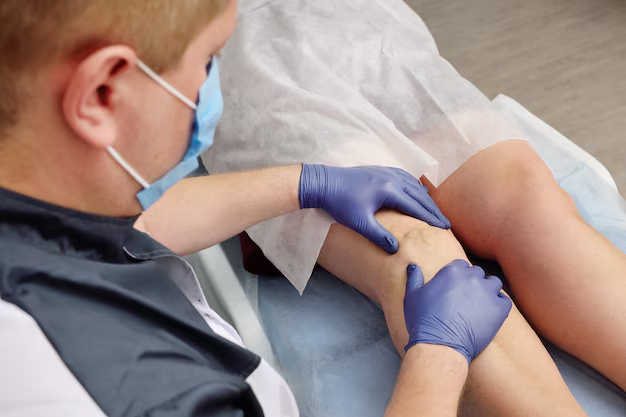
Why would you need vascular surgery?
You may need vascular surgery if you have any of the following conditions:
- Aortic aneurysm.
- Blood clots.
- Carotid artery disease.
- Chronic venous insufficiency.
- Deep vein thrombosis (DVT).
- Fibromuscular dysplasia (FMD).
- May-Thurner syndrome.
- Mesenteric artery ischemia.
- Peripheral artery disease (PAD).
- Popliteal artery entrapment syndrome (PAES).
- Renal artery stenosis.
- Thoracic outlet syndrome.
- Varicose veins.
- Visceral and peripheral arterial aneurysms.
What are the different types of vascular surgery?
Many types of vascular surgeries and procedures treat a range of blood vessel issues. The type of vascular surgery you need depends on the condition you have.
Vascular surgery to repair aortic aneurysms
An aortic aneurysm is a weakened portion of your aorta (the largest artery in your body). You may need surgery to repair an aneurysm if it’s growing too large or causing symptoms. The goal of aortic aneurysm repair is to prevent serious complications like an aneurysm rupture or dissection.
Vascular surgeons use the following surgeries and procedures to repair aortic aneurysms:
- Aneurysm surgery (open): A surgeon makes a long incision in your chest or abdomen (belly). They remove the damaged part of your aorta (the aneurysm) and replace it with a fabric tube called a graft. The graft provides a new lining for your aorta, allowing a safe passage for blood flow.

- Endovascular aneurysm repair (EVAR): This minimally-invasive procedure treats abdominal aortic aneurysms (AAAs). These aneurysms form in the part of your aorta that travels through your abdomen. EVAR involves small punctures in your skin rather than a long surgical incision. Your surgeon places a stent graft (fabric tube with a metal mesh frame) at the site of your aneurysm. This stent graft provides a new path for blood flow.
- Thoracic endovascular aneurysm repair (TEVAR): This minimally-invasive procedure treats thoracic aortic aneurysms in your descending aorta. Aneurysms that form in your ascending aorta currently require open repair surgery.

Vascular surgery to treat peripheral artery disease (PAD)
Peripheral artery disease (PAD) refers to plaque buildup in the arteries that supply blood to your legs, arms or pelvis. PAD can interfere with your quality of life by causing symptoms like intermittent claudication. It also raises your risk of complications like blood clots and critical limb ischemia (pain at rest or wounds that may progress to gangrene).
Vascular surgeons manage PAD with:
- Angioplasty and stenting: An angioplasty is a minimally-invasive procedure. It widens an artery that’s grown narrow due to plaque buildup. A surgeon inflates a small balloon inside your clogged artery to clear a path for blood to flow. Plus, they often insert a stent (wire mesh tube) to keep your artery open. In drug-coated balloon angioplasty, the stent has a coating that helps prevent your artery from narrowing again.
- Atherectomy: This is a minimally-invasive procedure. A surgeon removes plaque from inside your artery using a catheter with a blade at its tip. Surgeons call this process “debulking” because it reduces how much plaque lines your artery walls. You may have this procedure along with balloon angioplasty to prepare your artery for stent placement.
- Endarterectomy: This is the surgical removal of plaque from one of your arteries. A femoral endarterectomy removes plaque from your femoral arteries, which lead from your groin to your leg. An aortoiliac endarterectomy treats aortoiliac occlusive disease by removing plaque in your lower aorta and iliac arteries.
- Peripheral artery bypass surgery: A surgeon creates a bypass, or detour, for your blood flow that avoids the blockage in your artery. Your surgeon uses a healthy vein from somewhere else in your body or artificial material to make this bypass. This surgery helps people with severe PAD.
Vascular surgery to manage problems with your carotid arteries
Carotid artery disease refers to plaque buildup in your carotid arteries, which supply blood to your brain. Plaque in your carotid arteries is dangerous because it reduces blood flow to your brain. Vascular surgery improves blood flow and lowers your risk of complications such as stroke or transient ischemic attacks (TIA).
If you have carotid artery disease, you may need:
- Carotid angioplasty and stenting: This procedure opens up your arteries by means of balloons and stents so blood can flow better to your brain.
- Carotid endarterectomy: This surgery, through an incision in your neck, removes plaque from your carotid arteries to improve blood flow.
Vascular surgeries that treat other problems with your carotid arteries include:

- Carotid artery aneurysm surgery: A carotid artery aneurysm is a bulge in your carotid artery that raises your risk of a TIA or stroke. Open surgery or endovascular stent grafting can repair the aneurysm and provide a safe path for your blood flow.
- Carotid body tumor surgery: Carotid body tumors are masses that form in blood vessels near your carotid arteries. These tumors may put pressure on blood vessels and nerves, leading to symptoms like hoarseness and trouble swallowing. Surgery can successfully remove these tumors and prevent future complications.
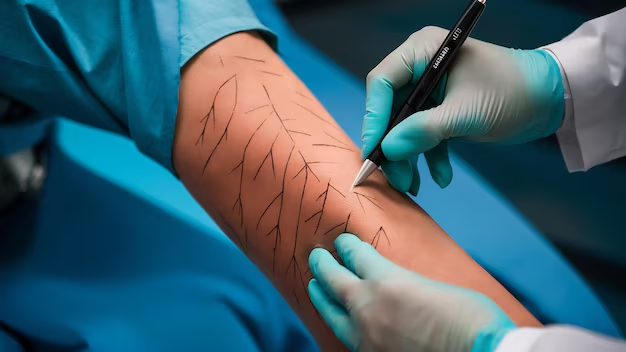
Vascular surgery to treat venous diseases
Your veins collect oxygen-poor blood throughout your body and carry it back to your heart. The veins in your legs contain one-way valves that help blood flow upward, against gravity, so it returns to your heart. Venous diseases damage the valves in your leg veins and prevent them from working as they should. As a result, blood begins to pool in your leg veins. You may experience symptoms (like leg pain or swelling) and complications (like blood clots or venous stasis ulcers or wounds).
Vascular surgery manages venous diseases and their complications. If you have a venous disease, you may need:
- Vena cava filter placement: A vena cava filter is a metal device that a surgeon inserts into your inferior or superior vena cava. These are large veins that send oxygen-poor blood from your body back to your heart. From there, the blood travels to your lungs to gain oxygen.
- The filter acts as a sieve, allowing blood to flow through but catching any blood clots before they enter your heart. It helps people who have deep vein thrombosis (DVT). It lowers your risk of a pulmonary embolism (a blood clot that travels to your lungs). The filter is either permanent (it stays indefinitely) or temporary (your surgeon removes it when you’re no longer at risk).
- Bypass surgery for venous disease: This helps people with severe venous disease who have a vein blockage. A surgeon creates a graft from a healthy vein elsewhere in your body. They use this graft to create a new path for blood to flow around the blockage.
- Vein ligation and stripping: This surgery treats varicose veins by removing diseased veins. It helps people with chronic venous sufficiency by easing symptoms and promoting the healing of venous ulcers.
- Endovenous thermal ablation: This is a minimally-invasive alternative to ligation and stripping. It uses a laser or high-frequency radio waves to close up a diseased vein. The vein stays in your leg, but it no longer carries blood. Your surgeon will tell you if you’re a candidate for this procedure.
- Sclerotherapy: This minimally-invasive procedure treats varicose veins and spider veins. Your surgeon injects a chemical solution into your vein to close it off. Sclerotherapy is most helpful for people who have small varicose or spider veins.
Vascular surgery to treat other conditions
Other types of vascular surgery include:
- Thrombolytic therapy: Also called thrombolysis, this procedure breaks up blood clots. Surgeons can use it in emergency situations, like if you’re having a stroke. They also use it to break up blood clots in people who have deep vein thrombosis or peripheral artery disease.
- Thoracic outlet syndrome surgery: Thoracic outlet syndrome involves compression of arteries, veins and/or nerves in your upper chest. If the syndrome affects your veins or arteries, you may need surgery to improve blood flow and manage symptoms.
- Popliteal artery entrapment syndrome (PAES) surgery: PAES causes compression of the popliteal artery in your leg. Surgery removes a small part of the muscle that presses on your artery to relieve the compression.

- Renal artery angioplasty and stenting: This minimally-invasive procedure slows the progression of renal artery stenosis. It widens a narrowed renal artery to improve blood flow to your kidneys.
- Surgeries and procedures to treat mesenteric ischemia: Mesenteric ischemia is reduced blood flow to your digestive organs. You may need open surgery (like an endarterectomy or bypass) or a minimally-invasive procedure (balloon and stent) to treat this condition.
- Dialysis access creation and maintenance: Dialysis helps you live with kidney failure by doing the work your kidneys would normally do (filtering toxins from your blood). To begin dialysis, you need a procedure that creates an access site. This access site allows your body to connect to a dialysis machine, which acts as an artificial kidney. To create access, your surgeon may create an arteriovenous (AV) fistula. Or, they may use an AV graft to connect an artery and vein. In emergencies, they may insert a catheter into one of your veins for short-term access.
What is the Procedure During the Vascular Surgery?
What happens during your surgery depends on the condition you have and the specific surgery you need. Your surgeon will tell you exactly what to expect. As a starting point, it’s important to learn whether your surgery will be open or minimally invasive. These are two different approaches that surgeons use to access your blood vessels.
- Open surgery: Your surgeon makes a long incision to directly access the blood vessel that needs treatment.
- Endovascular surgery: This is minimally-invasive surgery. Your surgeon uses smaller incisions or skin punctures rather than a long incision. They insert a catheter (thin tube) into an opening and guide it to the spot that needs treatment. Usually, recovery is easier compared with open surgery.
Talk with your surgeon about the type of surgery you need and why.
What happens after vascular surgery?
What happens after varies widely based on your specific surgery. Some vascular surgeries (like aneurysm repair surgery) require a stay in the intensive care unit (ICU). Other procedures (like sclerotherapy) require no hospital stay at all, and you can drive yourself home the same day.
Talk to your surgeon about what you can expect in the hours and days after your surgery. Your surgeon will give you instructions on how to care for yourself, including caring for any incisions.
